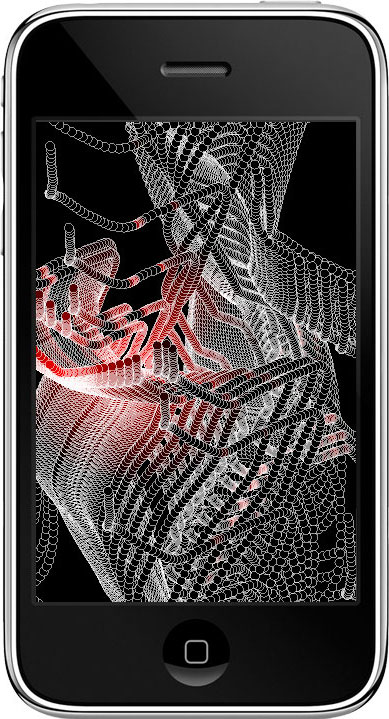
As the niche genre of software art expands beyond the web and into mobile devices, media artists are finding ways to integrate their work into a new form of business model. Instead of giving away your work for free on the web, Apple's iPhone and iTouch devices provide an ample platform for distribution (through the Apple App Store) and hardware support for novel ways to experience screen-based work. Since the App Store was unveiled last year, the over 30,000 available applications have taken the form of everything from mock cigarette lighters (Zippo's App) to mobile flutes (Ocarina) to utilitarian apps such as Urban Spoon (Restaurant finder) to social networking in physical spaces (Loopt). Noticing this trend, media artists who once found their free and limitless distribution platform through a desktop computer browser are now turning their attention and creative efforts toward the mobile space of the iPhone.
Noticing this shifting dynamic toward the mobile space, early pioneering web and software artist Lia began the website, iPhoneart.org, which aims to aggregate several artist-created applications that use the touch-screen and accelerometer functions of the devices in new and imaginative ways. Like her web-based work from the late 1990s, Lia's PhiLia 01 is an iPhone and iTouch application that integrates sound and simple motion graphics that the user can influence through touch and orientation of the device to create unique audio-visual compositions. Steph Thirion is another artist working in the abstract art realm of iPhone sound art. His application Eliss is both an innovative game and music creation app that features an odd array of geometric shapes or "blendable planets" that the users have to manipulate to "fit" together. This abstraction is reminiscent of 80s arcade games graphics and adds a nice alternative retro look to the iPhone's slick GUI operating system.
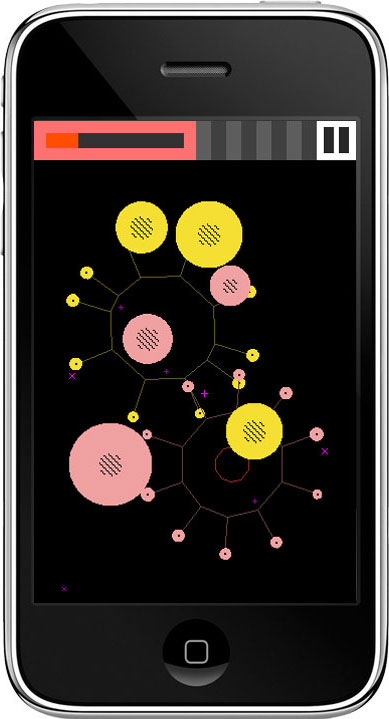
Within the genre of apps that pay homage to artistic practice of the past, is a collaboration between media artists Memo Akten and Miltos Manetas (who is well known for his paintings of outdated computer tech such as Zip drives) entitled Jackson Pollock. This multi-touch app allows "painters" to choose their colors and "drip" on the device's screen in a similar aesthetic to Jackson Pollock's drip paintings. This dripping aesthetic is also evident in Theo Watson's app, FATTAG, which is a handheld version of the software used by the Graffiti Research Lab on their building size LaserTAG projections. The app allows you to sketch graffiti on the screen with your fingers, while virtual "paint" drips from each line drawn.
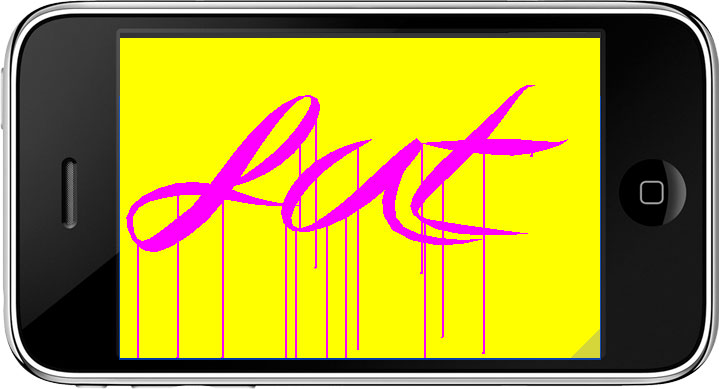
Working with abstract text compositions is artist Andreas Müller and Nanika's For All Seasons a free iPhone app that integrates several poetry pieces with data visualizations of this text. In this app, users first choose a season from "Winter, Autumn, Summer, and Spring" which then prompts a piece of text to appear onscreen that can be manipulated through touching the screen. This piece was originally made in 2005 for the computer desktop and the artists have adapted it for the iPhone in order to gain familiarity with iPhone programming. "Spring" features some prose about Dandelion flowers and changes into some blooming stalks of the flowers on a white 3D plain. Aya Karpinska's Shadows Never Sleep also works within the world of interactive narrative and visual output on the iPhone. The application features a zoom-able fiction piece that takes advantage of the device's multi-touch capabilities. Users continuously zoom into the black and white images to reveal a story in both text and illustration as they move through the landscape.
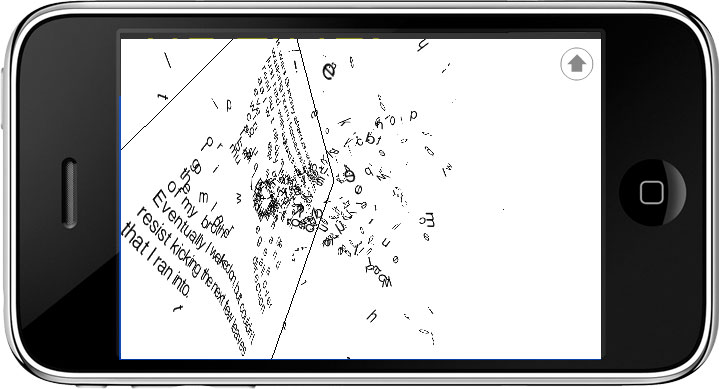
Moving away from narrative design and delving deeper into abstract visual and sound compositions is SynthPond built with Open Frameworks (a C++ library) by NYC-based artist, Zach Gage. Although Gage professes the app as more of a "sound toy" (inspired by the work of Japanese artist Toshio Iwai) than a game or poetic experience, the project uses the simple premise of adding nodes to a field, where rings of color emanate from each placed object. When the rings hit other objects they create sounds, which then add to the overall composition. This form of fluid composition is something that works seamlessly on the iPhone since it requires no learning curve and is accessible and understandable by most users.
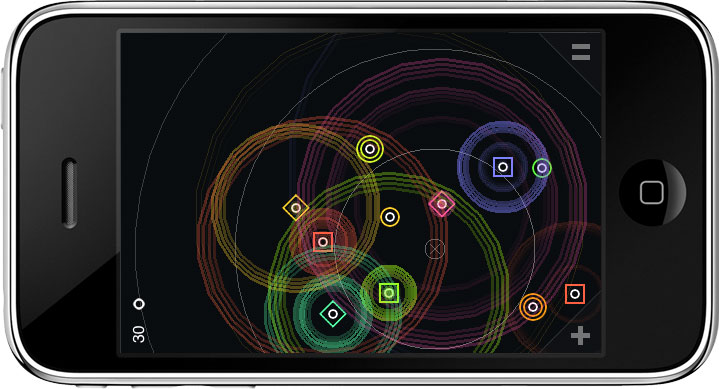
Integrating software systems and rules into his iPhone art creations, world-renowned web and software artist Joshua Davishas created the JD Reflect app. This app is a generative imaging system that uses both graphical elements and color swatches to create kaleidoscopic effects from randomized processes initiated in software by the artist. The idea of the app is to enable the generative creation of limitless final designs using an algorithm to dictate the output. Thus, the resulting creations are unique for each user of the app.
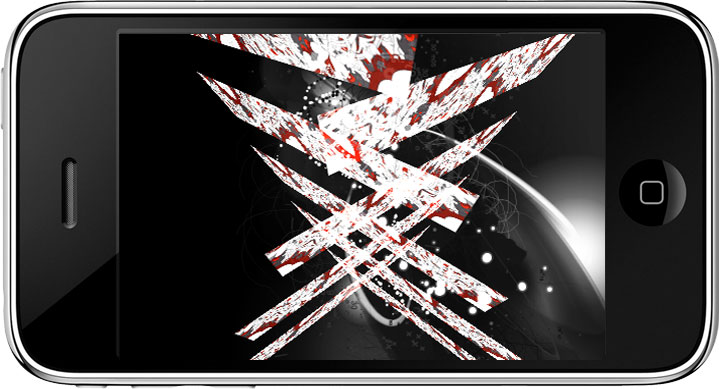
Reality Jockey’s RjDj app also uses the iPhone as a generative sound system. The app is ambient music composition application that uses the built-in microphone of your iPhone to capture ambient sound throughout your day and create sound pieces that can be uploaded for free to the RjDj server and given a URL that your friends can use to find your live recordings. It can be thought of as a live audio blog application that uses microphone data and accelerometer data to create a dynamic sound piece. This form of real-time data acquisition with uploading capabilities to the web is increasing the iPhone's ability to become a mobile diary of sorts, where artists can use elements from the user's immediate environment to channel inputs into their work.
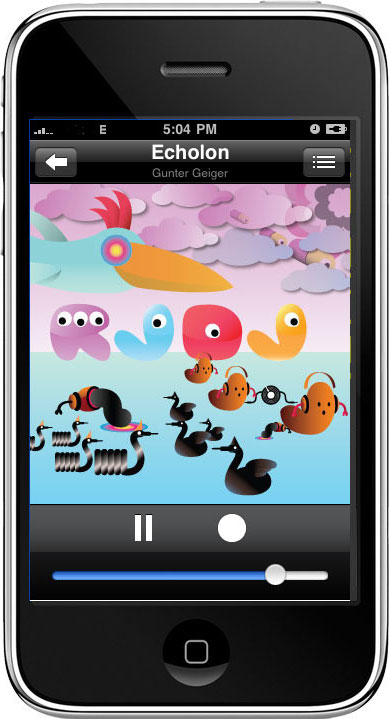
Since the iPhone has the ability to detect its own movement, listen to surrounding environments, know when it is being touched, and connect to the Internet, it provides a plethora of opportunities to engage with these sensing capabilities. Meshing the real world and digital gaming is Audible Realities, an artist collective who have developed several artistic and fun apps. Their ultra-creative World 9 application delves into the world of 8-bit arcade games by meshing this old school gaming environment with the real world. Simple, yet effective, the app merely connects the iPhone's accelerometer data to the sound of Mario from Nintendo's Super Mario Brothers’ jump sound. So as the user physically jumps up and down, it triggers the jump sound from the game. The app also networks this jumping movement to other "players" around the globe and features a built-in map to see where others are jumping. This is similar to the Ocarina app's built in map to see where and what others around the planet are playing on their iPhone flutes.
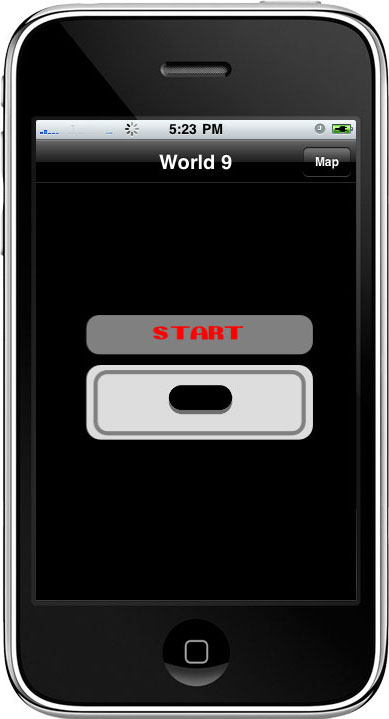
Although the apps mentioned in this article simply scratch the surface of the multitudes of projects that artists are creating for these devices, they demonstrate the endless possibilities they engender. By writing code that utilizes the sensing capabilities of these devices such as their immediate location, orientation, ambient noise levels, and more, there are even more possibilities to harness these elements into inventive and clever visual and auditory output. Since Apple has kept the economic barriers for entry into this world of mobile development relatively low, it's easier than ever for artists to use these devices for their creations and have an instant audience of millions to enjoy them. Whether you are looking to expand your artistic career or simply push the boundaries of these devices, the iPhone is a unique platform for experimentation and play for media artists to engage with audiences around the world.
Jonah Brucker-Cohen is a researcher, artist, and Ph.D. candidate as an HEA MMRP (Multimedia Research Programme) fellow in the Disruptive Design Team of the Networking and Telecommunications Research Group (NTRG), Trinity College Dublin. He is an adjunct assistant professor of communications at NYU's Interactive Telecommunications Program (ITP). He is co-founder of the Dublin Art and Technology Association (DATA Group) and a recipient of the ARANEUM Prize sponsored by the Spanish Ministry of Art, Science and Technology and Fundacion ARCO. His writing has appeared in numerous international publications including WIRED Magazine, Make Magazine, Rhizome.org, and Gizmodo, and his work has been shown at events such as DEAF (03,04), Art Futura (04), SIGGRAPH (00,05), UBICOMP (02,03,04), CHI (04,06) Transmediale (02,04,08), NIME (07), ISEA (02,04,06), Institute of Contemporary Art in London (04), Whitney Museum of American Art's ArtPort (03), Ars Electronica (02,04,08), Chelsea Art Museum, ZKM Museum of Contemporary Art (04-5),Museum of Modern Art (MOMA - NYC)(2008), and the San Francisco Museum of Modern Art (SFMOMA) (2008). He blogs at coin-operated.


"Since Apple has kept the economic barriers for entry into this world of mobile development relatively low, it's easier than ever for artists to use these devices for their creations and have an instant audience of millions to enjoy them."
Excuse me? You have to not only purchase an iPhone to use this software, you have to also develop on an Apple system, and you have to distribute it through an Apple store. As well as paying for the "ability" to become a certified developer. As well as requiring your applications to be "approved" before being available to others (forget about anything involving sexuality, "obscenity", critiques of Apple or its partners, or so on). How is this keeping the "economic barriers" "low"? I have to say I am getting quite disgusted with all of the prostrations at the Altar of Apple since their system only gives off the specter of being open, when in actuality it is an entirely closed, hermetic system. Why not valorize other platforms that are more open, such as Symbian, Series 60 Python, OpenMoko, the varieties of mobile Linux, etc? Oh right, those platforms are used by the "masses" or "tech heads", not the iPhone-toting artistic "elite".
sounds like you're not one of us iPhone-toting artists. don't hate the players.
the keyword there is 'relatively low', meaning, it's not totally impossible. and it might not be THAT easy, but it's easier than before. once you actually conformed to doing it the Apple way, then you'll find that there's a reason why the system is "closed, hermetic" as you say. i mean, sure, other platforms are opened and artists could develop of those if they want… but, dude, have you SEEN the phones that those platforms run on??
but don't listen to me, i'm one of the elitists. just sayin.
@nick, i think you're being unfair. I agree that the closed-system nature of apple products can be hateworthy at times. but keep in mind the silver lining of the closed-system cloud.
hating closed systems is analogous to hating computers in general, because they set up a barrier to enjoying digital art. what does a poor kid living on a trash heap in mogadishu care about whether or not the art is on an iphone or on symbian?
the importance of the iphone is that the experience is seamless. this is tech art for people who still distrust computers as art media. there are still many people out there who don't know openMoko or series 60 from a hole in the ground, and if you do not keep that in mind, you are limiting your audience in a major way.
@nick I have to say, having had coded for both S60, Symbian, Palm OS, WInCE and Windows Mobile Edition and the iPhone OS, the iPhone OS is in an entirely different league if we say that time to get something done has an economic value. Nothing beats the iPhone OS presently (unless Android does, but I have to plead ignorance on that one) for a complete, well-integrated SDK _and_ API and a channel to distribute your stuff. All of those things you pix-nick about matter, but I don't think they're cause to bust-balls to the point JBC is making here — that this is a transformative platform for creative expression in your hand. Sure — the iPhone is the phone for people with a job and a bit more walking around money to throw around — what is it? $99 now? New? Probably a lot less in the secondary markets? And you'll need a Mac, I guess. Or a Hackintosh for $299. And a $99/year subscription to the Apple Developers Network. I guess you're in for an budget-busting $500, all-in.
*sigh*
Go grouse about the man/system/great-oppressor on nettime, bub. This here is good, playful, invigorating stuff that real people are making and crafting and creating.
So Amazon's decision to force Apple to pull a popular application due to its so-called "violation" of Amazon's API terms of service is okay?
http://www.pcworld.com/article/168019/delicious_library_iphone_app_yanked_from_app_store.html
What I am "hating on" is the seeming effacement of the materiality of the digital: that is, the ways in which the computational devices we use are involved in processes of capital. While we can condemn nearly every device manufacturer in the world because of one or another of their business dealings, we do not want to simply dismiss the digital and computational world altogether—nor do we want to swing to the other end and blindly accept the activities of corporations unquestioned. What we need is judgment and criticality, a lack that I read in the article and that I was responding to—in a polemical fashion, indeed.
More to the point, however, is the ways in which the hype over iPhone applications suggests that Apple is the most appropriate entity for making the software ecosystem necessary for creating great software. Why should we focus our efforts in that direction, rather than concentrating on the development of networks that enable others to write code that is better than Apple's so-called "ease of use"? Why should we not use our positions as artists and educators to encourage our students/viewers/participants to explore these other options, to help lay the groundwork for systems that do not have such a pernicious relationship to capitalism and to authority? Why should we not be working to create the conditions for the "organized networks" that Ned Rossiter writes about? Why can we not use FLOSS as a pedagogical moment to explore these issues?
I am very aware of the problematics of FLOSS culture, being involved in it for over a decade now. However, the seemingly blind acceptance of Apple (and commercial development in general) that I see here and elsewhere, with little consideration of alternatives, forces me to take a stance towards FLOSS that valorizes them, rather than working to remedy FLOSS' own problems.
Just wanted to chime in here to point out that none of these comments have anything to do with the "ART" itself, which is what the piece was focusing on. I guess Nick is the main culprit here who obviously didn't even look at the art discussed and basically created a punching bag of the iPhone platform. It seems that hardware will always eclipse software. Nice try, thanks for attempting to read though.
My comments have _everything_ to do with the art. Is art immaterial now? Are you saying that these artworks somehow belong to some phenomenal realm that do not have their realization in material? If so, I concede. However, as far as I understand, these works exist in material form; and that material form is the iPhone platform. Therefore the artwork is inevitably tied to the materiality of its realization. Now, I would not continue on my polemic here if there were some understanding in the article about the limited nature of this software; of its embeddedness within a closed system controlled by a corporate entity; and if the author were not so disingenuous in suggesting that the iPhone is somehow a more "open" system than others. If there would have been that level of criticality, then we could talk about the specific configurations of material (the hardware and the written software)—the "art" as you claim I am not writing about. Until we have that sort of discussion—one that, yes, has gone on for years, but, given the preponderance of use of closed systems for art these days (Second Life, Twitter, iPhone, etc.), seems to be more apropos than ever—I see this as nothing more than an advertisement for Apple.
With that said, the artworks under discussion seem to not be using the specific capabilities of the mobile phone platform itself. So we can now have "virtual" dripping of paint? Does the paint drip or splatter when the phone is on the floor? Can we use the phone to tell us when to urinate in Peggy Guggenheim's fireplace? The RjDj piece seems to be more apropos to the mobile phone platform, as I've always considered the platform as the easiest and most direct way to have a mobile microphone, and therefore helping with the creation of works of musique concrete or field recordings.
Nevertheless, I find most of the examples to be derivative of earlier software art and therefore not using what mobile phones are best at, namely communication. Nevertheless, I know the reason why, and it has _precisely_ to do with the limitations that Apple places on the iPhone platform—which are therefore limitations in materiality. The issue here is with how Apple limits background processing on the phone, as well as low-level access to things such as Bluetooth. Thus, when I have considered porting some of my Series 60 work to the iPhone (while I was questioning whether I wanted to do that in the first place), I realized that I couldn't, that I was entirely limited (artificially, mind you) by Apple themselves. This will severely constrain the types of work that you will see on the iPhone as long as Apple holds such an iron fist on the capabilities they make available to the developer. And therefore will constrain the types of applications—artworks—that you might see on the phone. And so we're back at the beginning again, full circle, with the relationship between materiality and the types of artworks that can be made. While material limits often can be enabling for an artist, why should we accept limitations that have less to do with the material itself, and more to do with the processes of value extraction?
It's Pollock not Pollack
I never mentioned that the iPhone was "more open" once, I just mentioned that Apple has sold over 31 million iPhones which is more than any of the platforms you mentioned, thus giving these artists a huge audience - rather than a niche one which the open platforms you mentioned cater to.
Hi,
Totally agree with nick on this subject. The expression 'iPhone Art' should be questioned on every level - what does it mean? That the work is exploring the possibilities of the iPhone? Assuming that is what is meant, then most of the work covered in the article misses the point - it seams to be using the possibilities of a sexy, nice screen activated by touch - it is not really exploring what the mobile phone is, as nick said - a communication tool and, I add, a sensing device of everyday life. Even if these are issues to be explored, they are not an iPhone creation, they were not invented by Apple and it is not Apple's role to access their validity.
sofia
hello hello hello
I don't want to get in to deep here… but while in Korea… I did some poking around for multi-touch tables, as I had heard it was a good market to find these types of things. The starting cost for most of the table kits was 5 to 6 thousand and up.
until costs come down… wide spread use of a multi-touch device to create work for mass consumption is just to far off at the moment.
oh… wait.
yeah, I can only say for myself… but having a multi-touch platform for under a few hundred bucks available right now on both iPhone and iPod touch is what drove us to experiment on this platform in the first place. ok ok ok yes it's mobile… but mobile was not the #1 driving force for us… Multi-touch was… being mobile was the icing on the cake.
so nick… or anybody else for that matter… instead of complaining… build us an AFFORDABLE multi-touch / mobile device with a solid OS (unix/linux preferably) and platform for delivering content and we will all experiment and publish content for it.
For me… it's not how difficult the apple platform is for creating/publishing content… it's that it happens to be the best… out of box… affordable device… with all the features we'd like to develop with at the moment. So today is the day Nick… today is the day that you start your hardware/software company to satisfy all the needs and concerns of yourself and all of us. If you need a punch list of features and methods I personally would like to see implemented… I can e-mail you.
and while your working… I'll keep publishing under Apple's umbrella… until someone is brave enough to MAKE something that's better… instead of just TALKING about how things can be better.
I worked with the very very talented Marius Watz to produce a nice little nokia app that visualises messages and then lets you send this on as a graphic - It only really only runs on the Nokia E71.
http://www.flickr.com/photos/watz/sets/72157614375037675/
http://nokia.co.uk/e71
I think there is a lot of oppurtunity for mobile platforms to enhance creative art (using gps, camera, video etc) or even coding on the move as some of these phones are so sophisticated they can do this.
Really exciting times.
First off just a disclaimer I wrote synthpond so I'm bound to be biased, but I'm trying not to be.
@nick
I don't disagree with you, I think that at some point looking at apple's stranglehold on the mobile market will be important, I just think that what you're discussing was a bit outside the scope of this article. The article was clearly targeted at pointing out a market for art with a low entry barrier, and exploring some of the possibly interesting things that are appearing in that market.
It's easy to make the ascetic argument in art because it's impossible to disagree with. The problem is, at some point, nearly everyone compromises being true to "art" and getting paid. Everyone has their own line to cross, most of us can't or don't want to be squatting in apartments in Detroit, growing vegetables and drawing with rocks.
I'm not saying that we shouldn't be as open and free as possible, and most of us are. synthpond I sell to make money, but I also give away an extremely full-featured free version, as well as all the tools I used to make it, and I help people learn those tools.
Maybe this is all under the "Apple" umbrella, but that doesn't make the practices and interactions worthwhile. And this is what I'm saying, that it's easy to attack the Big picture if you ignore all of the small things that are going on. If you want to discuss the righteousness of different mobile platforms for art, I think that would make a great Rhizome article in itself, and maybe you should write it, I'm sure you would get a lot of interesting discussion.
As far as this article goes, it's a shame to lose sight of discussing the ideas. Isn't that the point of doing all this art stuff in the first place?
To that end,
@Sofia
should they be exploring what it is to be on an iPhone? And don't they? Sure not all of them, but I think for the most part many of these apps explore what it means to have something in your pocket all the time, and address the context that they will be seen in. Not all great paintings are about what it means to be a painting, but they all address what it means to be on a wall. And I think many of these apps do the same thing, some (rjdj and world 9 in particular) better than others.
To that end, this isn't all about cellphones. ipod touch apps are not on devices meant for communication.
Further, should Apple be assessing their validity? Clearly no, and this is a problem that has been brought up many many many times. But that's life. It's unreasonable to throw out an entire realm of exploration and discussion because it's not completely free or fair.
Hi Zach,
Agree that 'It's unreasonable to throw out an entire realm of exploration and discussion because it's not completely free or fair'
I was just pointing out that the opposite should also be questioned, and calling the article 'iPhone and iPod Touch App Art' seams to be a bit exagerated and acritical position. Also, from a market point of view Apple did not invent the apps market, it was already there, anybody could have done it using other distribution channels to sell the work. What Apple did really well was to centralise the all process and thus made it easier for users to acess the content - but then again is a business strategy. besides easy is not normally what defines line of thought in artistic practice.
best,
sofia
We all love seeing artists take advantage of new platforms and technologies, and it's really exciting.
Perhaps what I found disturbing is the fact that art itself is being presented as a product. I'm not a purist at all, I often find it difficult to draw the line beetwen work and art, so that's not really it.
when Jonah writes:
"As the niche genre of software art expands beyond the web and into mobile devices, media artists are finding ways to integrate their work into a new form of business model. Instead of giving away your work for free on the web, Apple's iPhone and iTouch devices provide an ample platform for distribution (through the Apple App Store) and hardware support for novel ways to experience screen-based work"
I can't help but feel that the business model part is getting all the attention. take nick's comments for example, focusing more on the platform and it's closed model than the art itself.
Back in the days, we've seen these artists "giving away their work for free".
I guess I can't seem to fully understand why this has to change when the platform changes. You had to pay for server space, bandwith and development to make web work, so I don't think that the development/publishing cost is the real issue here.
and Nick, you know you can always develop for the jailbroken iphone/ipod, take full advantage of the device, and distribute your work freely through the repositories.
valerialaura,
I totally agree. it is a little sinister.
I think part of it is that when the business model is all taken care of, it's so easy to look at the app store, see that it's blowing up, and then be unable to resist the temptations of just attaching a price and making a bunch of money.
For me, I decided to set an amount of money that I wanted to make, after which point I turned the application into a free version.
Also interesting here though, is that the appstore has a strange community. synthpond is rated outrageously higher for the version I charge for, and I suspect this would be the case with most art+apps because they require/encourage creative curiosity. A lot of people who download apps are just looking for something to entertain them, not something they will have to engage with, and putting a money barrier in front of an experience ensures that the feedback you'll be getting comes from people interested in engaging with art. It sounds weird to be splitting in an audience like this, but a lot of traditional art does this as well, by putting things in museums and galleries. Of course there's always street art, and I guess iphone art could be tailored to the broader community (I guess Bloom is kind of like that), but it's a strange balance. I guess that doesn't really support charging money, but I thought I'd throw it in there. Also, not all the apps on this page charge. World 9 and For All Seasons are free I believe.
It’s always exciting to see new platforms being used and explored by artists. I like the RjDj app a lot because of its powerful poetics. The way in which it transforms daily life into new and unpredictable audio narratives is fantastic. After reading Jonah’s article, I checked the iPhoneArt website but was a bit disappointed with the small number of apps on offer. I really do hope that much more experimental stuff gets added in the upcoming months. Talking about experimental: a good dose of subversion would be healthy. I agree with most of the complaints about Apple’s business model - but I’m not sure if that’s so relevant for a discussion of the actual projects that are presented here. We need more critical art in this field. Why not make apps that actually criticize or play with Apple’s business policies? Or with corporate-monopolistic policies in general. On another note: how to make all these apps more ‘sustainable’. My (admittedly limited) experience with these apps is that people download them, try them out for 5 minutes… and then hardly ever use them again. How to make apps that have a deeper and longer lasting impact. Things that get more embedded in daily life. Experiences that are as compelling as a good game, an absorbing narrative, or an album you keep listening to. Curious to see stuff like that.
Why is it that no one has a problem when poems, short stories, and novels sell on the web for their value (a downloaded e-pub costs only slightly less than the paper version), yet people think interactive art should always be free? Is it really less 'art'? Less work?
I've been making web and interactive art for a long time with absolutely no way to live off of it, being forced instead to work a corporate art job to pay the bills. I love making it and will always do it, but it takes time and it is work, and it's depressing to know that I'll never be able to sell anything. Am I a sellout to rejoice at a way to get paid (like my brush-wielding friends)?
I don't think of Apple and the iTunes Store as the art form, I think of them as a Gallery. They show and promote the work to a satisfyingly huge number of people and demand 30% for doing so. This is a system that has existed almost as long as art has been sold (in fact 30% is quite generous compared to galleries I've seen). It is not 'sinister' or even unusual that iTunes will choose to accept or reject works according to it's own standards. Joshua Davis is correct when he asks for a new platform… a truly open one, maybe then we can have multiple galleries offering works for mobiles across a variety of tastes, hopefully it won't go back to just 'everything is free'.
and instead we live in the ideal and fantasy of what Summer becomes. We anticipate this time of year with a child like earnestness and we willfully throw ourselves into a haze, from which we slowly find our way back into reality.
i am confused, who won the webby award ? the website iPhoneart.org or any artworks inside the website. What's so unique about the website iPhoneart.org anyway ? Any new concepts introduced ? any questions raised ?
I believe functionality comes first than we can speak about design and art. Yes, I know in case of the iPhone not only the features but also the design plays an important role when somebody decide on choosing an iPhone. By the way I work at a software development company and I know that my colleagues - the app developers - don't care about art so it would be hard to collaborate with them to prepare any application, which main function is about "beauty".